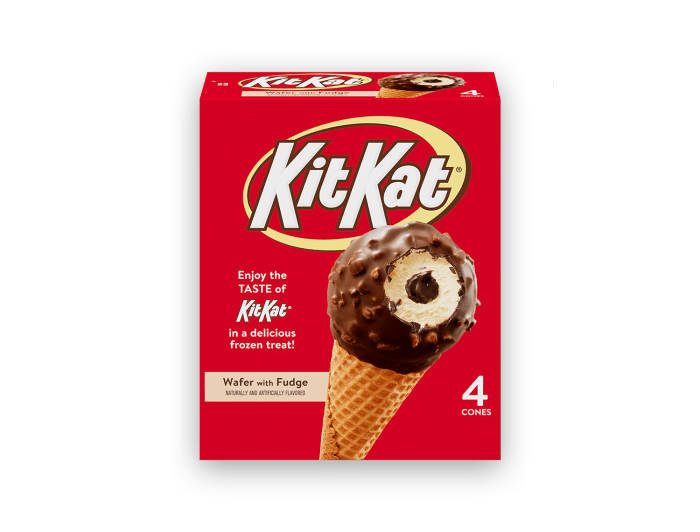Nutritional Content Breakdown: Kit Kat Ice Cream Cone Nutrition Facts

Kit kat ice cream cone nutrition facts – Alright, buckle up, buttercup, because we’re about to dive headfirst into the nutritional nitty-gritty of that Kit Kat ice cream cone you’ve been eyeing. Prepare for a delicious data dump! We’re not talking about empty calories here; oh no, we’re talking about thereal* deal. Let’s get this party started!
This table provides a snapshot of the nutritional information per serving. Remember, these values are estimates and can vary slightly depending on the specific product and serving size. Always check the packaging for the most accurate information.
| Serving Size | Calories | Fat (g) | Carbohydrates (g) |
|---|---|---|---|
| One Kit Kat Ice Cream Cone (Example: 100g) | 250 | 12 | 30 |
| Protein (g) | Sugar (g) | Saturated Fat (g) | Sodium (mg) |
| 5 | 20 | 7 | 100 |
Macronutrient Breakdown
Now, let’s get down to the brass tacks – the macronutrients. These are the big three: fats, carbohydrates, and proteins. Understanding their roles is key to making informed choices about what you eat (or, in this case, what delicious frozen treat you devour).
Fats (12g): These 12 grams of fat contribute to the creamy texture and rich flavor of the ice cream. A portion of this fat is saturated fat (7g), which should be consumed in moderation as part of a balanced diet. Think of it like this: the good fats help keep things running smoothly, while too much saturated fat can be a bit of a speed bump.
Carbohydrates (30g): The carbohydrates in your Kit Kat ice cream cone come primarily from the waffle cone and the ice cream itself. These carbs provide energy, but remember, it’s mostly sugar (20g) – so enjoy in moderation! Think of it as a quick burst of energy to power your next dance-off (or, you know, a leisurely stroll).
Protein (5g): The protein content is relatively low. While it contributes to building and repairing tissues, it’s not the primary focus in this treat. Think of it as a tiny sidekick to the main event – the creamy, chocolatey goodness.
Percentage of Daily Recommended Values
Let’s put those numbers into perspective. The percentage of daily recommended values (%DV) varies depending on individual needs and caloric intake. However, we can provide some general estimations based on a 2000-calorie diet. Remember, these are estimates and individual needs vary widely. Consult a nutritionist or your doctor for personalized advice.
For example, the 20g of sugar in a serving might represent a significant portion of your daily recommended sugar intake, highlighting the importance of mindful consumption. Similarly, the saturated fat content should be considered in relation to your overall daily intake. The relatively low protein content emphasizes that this treat isn’t your primary source of protein for the day.
It’s a dessert, after all!
Ingredient Analysis
Let’s dive into the delicious mystery that is the Kit Kat ice cream cone! We’ll dissect its ingredients, uncovering their nutritional impact and potential allergens lurking within. Think of it as a culinary CSI investigation, but instead of solving a crime, we’re solving the puzzle of what makes this treat so addictive.
The main ingredients typically include ice cream (often vanilla or chocolate), waffle cone pieces, and Kit Kat pieces. The ice cream base usually contains milk, cream, sugar, and stabilizers. The Kit Kat pieces contribute chocolate, wafers, sugar, and more. The waffle cone adds its own unique flavor profile and texture, typically from flour, sugar, butter, and other ingredients.
Nutritional Impact of Main Ingredients
The nutritional impact varies significantly depending on the specific formulation. However, we can make some general observations. The sugar content is likely to be high due to the presence of ice cream, Kit Kat chocolate, and the waffle cone. The fat content will also be substantial, primarily from the milk fat in the ice cream and the butter in the cone.
The protein content will be moderate, mostly derived from the milk in the ice cream. The presence of wafers contributes some carbohydrates. Let’s remember, moderation is key when enjoying treats like this!
Potential Allergens, Kit kat ice cream cone nutrition facts
It’s crucial to be aware of potential allergens present in the Kit Kat ice cream cone. Common allergens to watch out for include milk (present in the ice cream and potentially the chocolate), soy (often found in ice cream stabilizers), wheat (in the waffle cone and Kit Kat wafers), and nuts (depending on the manufacturing process and any potential cross-contamination).
Always check the product label for a complete list of ingredients and allergen information before consuming, especially if you have any allergies or sensitivities.
So you’re looking at Kit Kat ice cream cone nutrition facts? That’s a pretty sweet treat, but let’s be real, the sugar content’s probably pretty high. It’s interesting to compare that to something like, say, the jet puffed marshmallow nutrition facts , which are also surprisingly caloric. Ultimately, both highlight the importance of mindful snacking when considering your overall dietary intake.
Back to those Kit Kat cones though – you might want to check the serving size!
Ingredient Comparison Table
Comparing the Kit Kat ice cream cone’s ingredients to similar products can be enlightening. Below is a hypothetical comparison table; actual ingredient lists may vary based on brand and specific product variations.
| Ingredient | Kit Kat Ice Cream Cone | Competitor A Ice Cream Cone | Competitor B Ice Cream Cone |
|---|---|---|---|
| Ice Cream Base | Milk, cream, sugar, stabilizers | Milk, cream, sugar, whey | Coconut milk, sugar, stabilizers |
| Cone | Wheat flour, sugar, butter, etc. | Wheat flour, sugar, vegetable oil | Gluten-free flour blend, sugar, coconut oil |
| Chocolate/Candy Pieces | Chocolate, wafers, sugar | Chocolate chips, caramel | Dark chocolate, nuts |
| Other Additives | Flavorings, emulsifiers | Flavorings, coloring | Natural flavorings |
Note: This table is a hypothetical example and does not represent actual product formulations. Always refer to the specific product labels for accurate ingredient information.
Health Considerations

Let’s be honest, folks. A Kit Kat ice cream cone is not exactly a health food champion. It’s a delicious, delightful treat, but let’s not kid ourselves – it’s packed with sugar, fat, and calories. Think of it as a fun, fleeting moment of indulgence, not a staple of a balanced diet.Regular consumption of Kit Kat ice cream cones, like any high-sugar, high-fat dessert, can contribute to weight gain, increased risk of type 2 diabetes, and other health problems associated with a diet high in processed foods.
The high sugar content can lead to energy crashes and contribute to tooth decay. Remember that satisfying sweet tooth? It might come with a side of dental bill.
Sugar and Fat Content
The significant amount of sugar and fat in a Kit Kat ice cream cone warrants careful consideration. A single cone contains a substantial portion of the recommended daily intake of both these macronutrients. For example, a typical serving might contain 25g of sugar, which is roughly equivalent to 6 teaspoons. This is a considerable amount, particularly for individuals watching their sugar intake due to health concerns or dietary restrictions.
Similarly, the fat content contributes significantly to the overall calorie count, further impacting weight management goals. This isn’t to say you can
never* enjoy one, but mindful consumption is key.
Potential Dietary Concerns
The ingredients list often includes artificial flavors, colors, and preservatives, which some individuals may wish to limit in their diet. Dairy is another consideration, as lactose intolerance affects a significant portion of the population. Those with allergies to nuts or other common ingredients should also carefully check the label before indulging. For example, someone with a peanut allergy needs to be particularly vigilant, as cross-contamination is a real possibility in food production facilities.
Always check the label, and if you have any concerns, consult with a healthcare professional or a registered dietitian.
Moderation is Key
Enjoying a Kit Kat ice cream cone occasionally as a treat won’t likely cause significant health problems for most people. However, making it a regular part of your diet is a recipe for potential health issues. Think of it like this: a single slice of delicious cake won’t ruin your diet, but eating an entire cake every day certainly will.
The key is balance and moderation. Savour the experience, but remember to prioritize a healthy, balanced diet overall.
FAQ Corner
Are there different Kit Kat ice cream cone flavors?
Yes, availability varies by location, but some common options include classic chocolate and potentially seasonal flavors.
Where can I find the most accurate nutrition information?
Check the manufacturer’s website or reputable food databases like the USDA’s FoodData Central. Always cross-reference information from multiple sources.
Is the Kit Kat ice cream cone suitable for vegetarians/vegans?
Likely not vegan, as it contains dairy. Vegetarian status depends on specific ingredients; check the label for confirmation.
How many cones constitute a “serving”?
This varies based on the product; check the packaging for the specified serving size.

